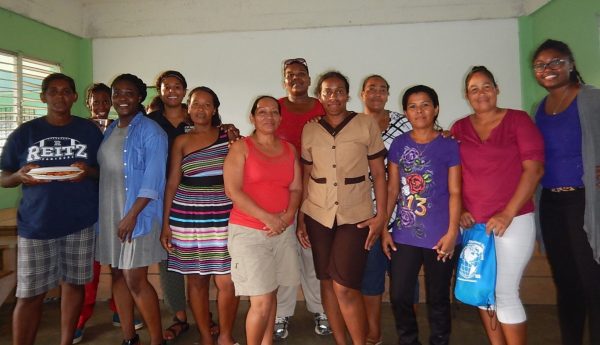By Shakira R. Hobbs, PhD
e-mail: srh3v@virgnia.edu
websites: shakirahobbs.com & biogals.com
 Dr. Shakira Hobbs is a Research Associate in the department of Civil and Environmental Engineering at the University of Virginia. Her research focuses on using engineering techniques to convert waste to valuable resources and utilizing behavioral science to understand the adoption of sustainable technologies. Currently, Dr. Hobbs leads a team of women, BioGals, researching sustainable waste management techniques in Sittee River Village, Belize. Dr. Hobbs plans to become an engineering tenure-track professor at a Research 1 institution conducting synergetic research.
Dr. Shakira Hobbs is a Research Associate in the department of Civil and Environmental Engineering at the University of Virginia. Her research focuses on using engineering techniques to convert waste to valuable resources and utilizing behavioral science to understand the adoption of sustainable technologies. Currently, Dr. Hobbs leads a team of women, BioGals, researching sustainable waste management techniques in Sittee River Village, Belize. Dr. Hobbs plans to become an engineering tenure-track professor at a Research 1 institution conducting synergetic research.
Early January 2017, I and two other Black women engineers were interviewed and discussed the movie ‘Hidden Figures’ and lingering challenges for women of color in engineering. Mixed in our excitement of finding more “like us” was melancholy. We were thrilled to connect with other Black women engineers; however, it was sad to hear that some of the same racial and gender inequities the Black women working at The National Aeronautics and Space Administration (NASA) confronted in the 1960’s, we were facing as well close to half a century later.
State of Engineering in the US
Currently in the US, there is a decline of Black women pursuing and obtaining engineering degrees. According to the US National Science Foundation, the percentage of Black women earning engineering degrees peaked in 2000 at 1.83% of the total obtained and has been declining since then. Black women engineers have to overcome negative preconceived perceptions that their peers may have of them. For example, a friend of mine (who is a Black woman with a PhD) was recently appointed as a postdoctoral fellow in an engineering department. She was asked if she had a background in engineering by a colleague in the same department. This implicit bias and other similar acts of discrimination, such as isolation and stereotype threat, make it grossly difficult for Black women in the field of engineering. I, like many Black women in engineering, desire to be appreciated for our knowledge and valuable experiences we bring to engineering. Of course, women and other underrepresented groups face similar hardships. But often times our identities and needs are lumped into one category and do not address intersectional identities. In a 2017 report titled Ignored Potential, several organizations such as The National Society of Black Engineers, Women in Engineering ProActive Network and Women in Science and Engineering have acknowledged the lack of data and research about Black women engineers. These professional organizations have joined together in requesting researchers to focus specifically on African American women to encourage their entry into the field and their upward mobility.
 To assist in this mission, I have combined my research interest in environmental engineering, waste to energy, and international development with my passion for creating opportunities and spaces for women of color through a grassroots initiative, BioGals. Through BioGals, I lead a diverse team of engineers seeking to increase the visibility of women of color solving complex problems that lead to sustainable solutions globally. What makes BioGals unique is that we take great pride in designing adaptive management techniques with community members by understanding their needs and values before suggesting possible solutions. BioGals currently consists of academic and professional leaders in engineering from across the US, working on the ground with partners at University of Belize and Sittee River Village Council in Belize.
To assist in this mission, I have combined my research interest in environmental engineering, waste to energy, and international development with my passion for creating opportunities and spaces for women of color through a grassroots initiative, BioGals. Through BioGals, I lead a diverse team of engineers seeking to increase the visibility of women of color solving complex problems that lead to sustainable solutions globally. What makes BioGals unique is that we take great pride in designing adaptive management techniques with community members by understanding their needs and values before suggesting possible solutions. BioGals currently consists of academic and professional leaders in engineering from across the US, working on the ground with partners at University of Belize and Sittee River Village Council in Belize.
Sustainable Engineering Research in Belize
Over the past three years, BioGals has been working with Sittee River Village on sustainable waste management techniques and recently published a peer-reviewed journal article on this research. Sittee River Village is a rural community located in Stann Creek District Belize, with a population of about 350 Belizean Creole–African and British descent–residents who struggle with waste management and economic development. As one would imagine, there are no collection services that pick up and dispose of trash in landfills. Transporting rubbish to the closest sanctioned landfill, located 50 miles away from the village, is not feasible or convenient since most people in the village do not own vehicles. This leaves villagers, typically women, with the responsibility of managing their own waste. From auditing waste, interviewing and surveying the village, BioGals learned that villagers manage their waste by burning, burying and/or disposing waste in the local river.
Earlier this year, I published a collaborative study that discussed sustainable approaches to disposing of food waste in small rural developing communities. We found that burying food waste contributed the most to global warming potential. The larger the amount of global warming potential, the more the greenhouse gases warms the Earth and accelerates climate change. Burying food waste emits 3029 metric tons of CO2 equivalent emissions annually, is the least favorable waste management technique, and has the most harmful environmental impact compared to burning and dumping in rivers. While burning food waste and throwing it in the river does not contribute to global warming potential, it produces pollutants. In addition, burning food waste produces carbon monoxide and particulate matter that can lead to respiratory infections. At the end of the study, BioGals shared our results with villagers and informed them of health and environmental impacts of their current methods of managing waste. As a result, some behavioral changes were observed. The Principal of the primary school, Ms. Yvonne Sabal, relocated the burn barrel and hole for garbage disposal further away from the primary school classrooms. Villagers recognized the severity of their current ways of managing waste and demonstrated a keen interest in finding alternative waste management systems that have economical value.
With the community, BioGals has identified ways to manage organic waste, stimulate economic growth, and assist in keeping Sittee River Village green via anaerobic digestion of food waste. Anaerobic digester or biodigester is a renewable energy technology that biodegrades and stabilizes organic compounds in an oxygen-free environment and produces biogas and biosolids that can be used as cooking fuel and fertilizer respectively. Biodogesters recover and utilize biogas instead of it being emitted into the atmosphere. The study I co-authored, found that switching from burying all food waste to using biodigester to manage waste results in 1032% decrease in global warming potential. The community buy-in and support of the biodigester is phenomenal and local resorts have committed to donating food waste to maximize cooking fuel and fertilizer products.
Implementation of Biodigeters: A woman’s touch
In the Summer of 2017, a small-scale personalized 3’x4’x4’ biodigester was built by BioGals and Sittee River Village Council. Sittee River Village councilman, Darren Ramirez, owns a successful construction company employing more than 75% of the village. The villagers collectively created the design and decided upon the materials for building the digesters. The project is currently in the trial phase to troubleshoot any design flaws and for villagers to make further improvements. The biodigester has the capacity to produce 7m3 of biogas per week, exceeding 60% of the primary school’s cafeteria cooking needs. Utilizing biogas as a cooking fuel displaces the dependency on the fossil fuel butane and cost savings of about $90 BZE per year.
Throughout the creation of the biodigester, BioGals served as advisors recommending criteria and parameters for successful design and operation. Traditionally, Sittee River Village is patriarchal; yet, BioGals researchers were welcomed and encouraged to participate in traditional male activities such as using power tools and mixing concrete to build the biodigester. While many were hesitant, women from within the village slowly began engaging by forming circles around us and observing as we built the biodigester. As time progressed, many women became vocal and recommended building a fence around the digester and compressing the gas in existing butane tanks.
Black Girl Magic
Throughout my time working with Sittee River Villagers, my colleagues and I have observed a distinct difference of how our experiences differ in Sittee River Village compared to the US. I have often wondered about our gender, skin color, nationality and if it played a role in the positive treatment that we were receiving from the African diasporic villagers. The research team, BioGals, relates to the villagers and are immersed in a supportive environment. The villagers not only view us as competent engineers, but socially accept us. We are invited to intimate activities such as birthday parties, cancer walks, and christening of a newborn baby. In addition, we met with the President of University of Belize, Dr. Clement Sankat (Guyanese and previously Vice-Chancellor of the St. Augustine Campus of the university of the West Indies) and faculty member, Dr. Abel Carrias and discussed the work we were doing in Sittee River Village. We feel valued and included as engineers and are not faced with the kinds of systemic factors that confront us daily, that exhaust us, that restrict our advancement in the US.
We were so surprised by the acceptance and support we received from the community that we decided to study the perceptions of Black American women working on engineering projects within their village. I am still analyzing the data; however, preliminary results show that Black women play a role in enabling social acceptance of the biodigester in Sittee River Village. Results from this study have powerful implications for:
1) broadening the participation of Black women in engineering both within the US and abroad;
2) alleviating systemic factors that restrict advancement in the field of engineering
3) empowering women in developing countries to be leaders in combating climate change, and;
4) providing recommendations for international NGOs and non-profit organizations engaging communities within developing countries.
BioGals continues to be engaged in conversations about expanding the project to fit the community’s goals. This summer, BioGals will be returning to work on some of these goals such as compressing the gas in butane tanks, building a greenhouse for the community garden, and gaining more insight from women since they do majority of the cooking. BioGals has empowered the community to take ownership of sustainably managing their waste and their capabilities for future innovations. In turn, Sittee River Village has empowered BioGals by providing us with a supportive and inclusive environment that embraces Black women engineers.

